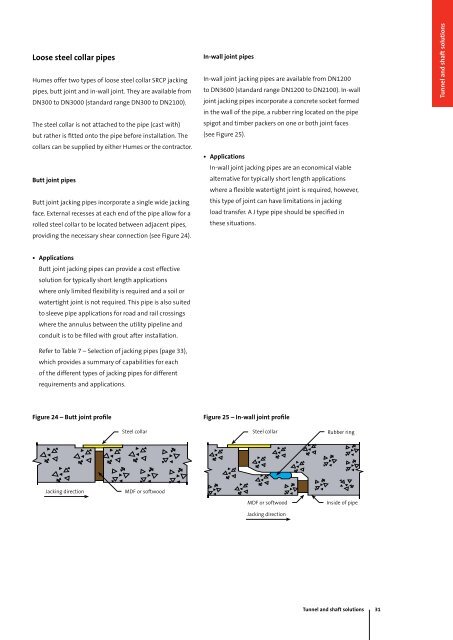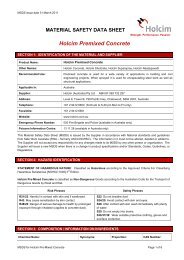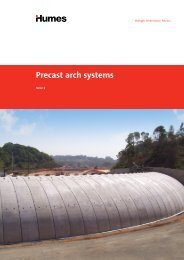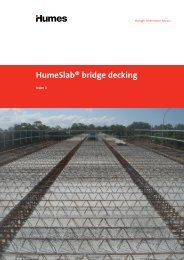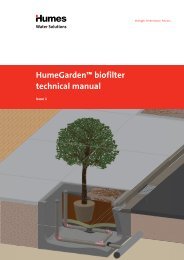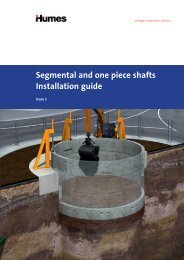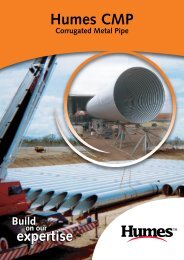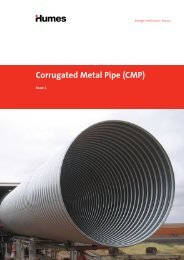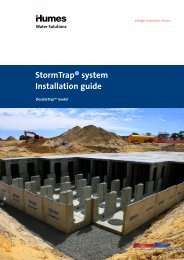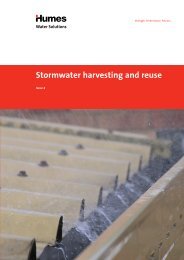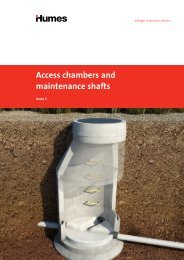Tunnel and shaft solutions brochure - Humes
Tunnel and shaft solutions brochure - Humes
Tunnel and shaft solutions brochure - Humes
Create successful ePaper yourself
Turn your PDF publications into a flip-book with our unique Google optimized e-Paper software.
Loose steel collar pipes<br />
<strong>Humes</strong> offer two types of loose steel collar SRCP jacking<br />
pipes, butt joint <strong>and</strong> in-wall joint. They are available from<br />
DN300 to DN3000 (st<strong>and</strong>ard range DN300 to DN2100).<br />
The steel collar is not attached to the pipe (cast with)<br />
but rather is fitted onto the pipe before installation. The<br />
collars can be supplied by either <strong>Humes</strong> or the contractor.<br />
Butt joint pipes<br />
Butt joint jacking pipes incorporate a single wide jacking<br />
face. External recesses at each end of the pipe allow for a<br />
rolled steel collar to be located between adjacent pipes,<br />
providing the necessary shear connection (see Figure 24).<br />
• Applications<br />
Butt joint jacking pipes can provide a cost effective<br />
solution for typically short length applications<br />
where only limited flexibility is required <strong>and</strong> a soil or<br />
watertight joint is not required. This pipe is also suited<br />
to sleeve pipe applications for road <strong>and</strong> rail crossings<br />
where the annulus between the utility pipeline <strong>and</strong><br />
conduit is to be filled with grout after installation.<br />
Refer to Table 7 – Selection of jacking pipes (page 33),<br />
which provides a summary of capabilities for each<br />
of the different types of jacking pipes for different<br />
requirements <strong>and</strong> applications.<br />
In-wall joint pipes<br />
In-wall joint jacking pipes are available from DN1200<br />
to DN3600 (st<strong>and</strong>ard range DN1200 to DN2100). In-wall<br />
joint jacking pipes incorporate a concrete socket formed<br />
in the wall of the pipe, a rubber ring located on the pipe<br />
spigot <strong>and</strong> timber packers on one or both joint faces<br />
(see Figure 25).<br />
• Applications<br />
In-wall joint jacking pipes are an economical viable<br />
alternative for typically short length applications<br />
where a flexible watertight joint is required, however,<br />
this type of joint can have limitations in jacking<br />
load transfer. A J type pipe should be specified in<br />
these situations.<br />
Figure 24 – Butt joint profile Figure 25 – In-wall joint profile<br />
Steel collar Steel collar<br />
<strong>Tunnel</strong> <strong>and</strong> <strong>shaft</strong> <strong>solutions</strong> 31<br />
<strong>Tunnel</strong> <strong>and</strong> <strong>shaft</strong> <strong>solutions</strong>


